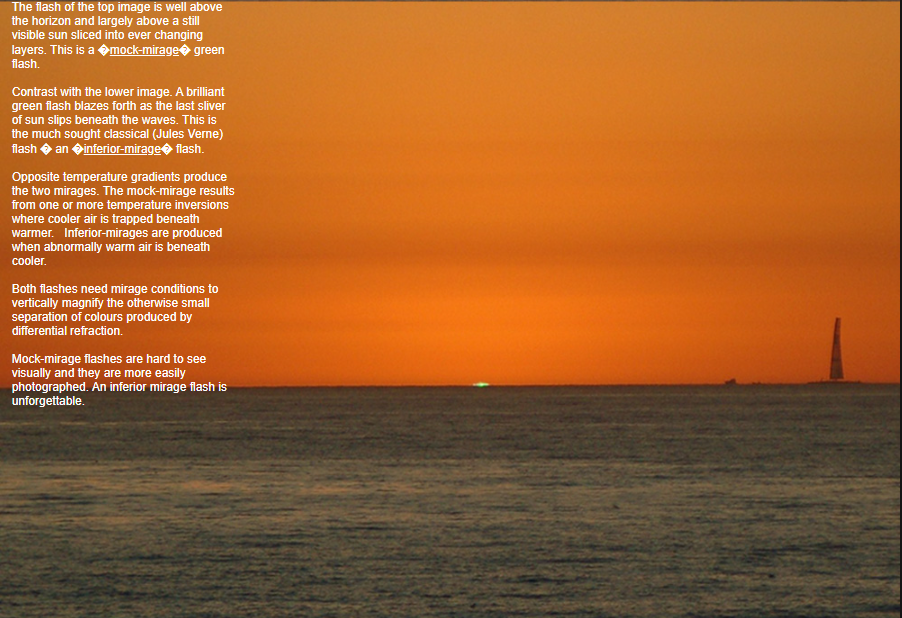OPOD - Green Flashes of two kinds
OPOD - Green Flashes of Two Kinds: Exploring the Spectacular Atmospheric Phenomenon
Green flashes, those elusive bursts of vibrant color that can be observed during sunset or sunrise, continue to captivate skywatchers around the world. In this article, we delve into the fascinating world of green flashes and explore the two different types that have been captured in stunning images by photographer Jim Grant along the Californian coast.
Mirage Marvels: Mock-Mirage and Inferior-Mirage Green Flashes
The first image captured by Jim Grant showcases a green flash that appears well above the horizon, towering over a still visible sun that is sliced into ever-changing layers. This type of green flash is known as a "mock-mirage" green flash. In contrast, the second image captures a brilliant green flash that blazes forth as the last sliver of the sun slips beneath the waves. This is the highly sought-after classical green flash, also known as an "inferior-mirage" flash.
Unraveling the Mirage Mystery
To understand the phenomenon behind these captivating green flashes, we need to explore the role of temperature gradients in creating mirages. Mock-mirage green flashes are a result of one or more temperature inversions, where cooler air becomes trapped beneath warmer air. On the other hand, inferior-mirage green flashes occur when abnormally warm air lies beneath cooler air. These opposing temperature gradients give rise to the two distinct types of mirages that produce the green flashes.
The Magic of Differential Refraction
Both mock-mirage and inferior-mirage green flashes rely on mirage conditions to vertically magnify the subtle separation of colors caused by differential refraction. The phenomenon of differential refraction occurs when light passes through layers of air with varying densities, causing the different colors of light to bend at slightly different angles. This refraction effect is what creates the stunning green flashes we observe.
The Elusive Mock-Mirage Green Flash
While mock-mirage green flashes are visually challenging to observe, they can be more easily captured through photography. These flashes, with their ethereal appearance above the horizon, present a unique opportunity for photographers to document this rare atmospheric phenomenon. The mock-mirage green flash captured by Jim Grant is a testament to the beauty that can be captured through the lens.
The Unforgettable Inferior-Mirage Green Flash
Inferior-mirage green flashes, like the one beautifully depicted in Jim Grant's photograph, leave a lasting impression on those fortunate enough to witness them. As the final sliver of the sun descends beneath the waves, a brilliant green flash blazes forth, creating a spectacle that is hard to forget. These flashes occur when warm air lies beneath cooler air, resulting in an inferior mirage that enhances the separation of colors and intensifies the green flash.
Unlocking the Secrets of Green Flashes
The study of green flashes not only ignites our sense of wonder but also offers valuable insights into atmospheric optics. By observing and analyzing these rare occurrences, scientists can gain a deeper understanding of temperature inversions, mirage formation, and differential refraction. Each green flash captured provides a piece of the puzzle in unraveling the intricate workings of our atmosphere.
Conclusion: A Glimpse into Nature's Visual Symphony
Green flashes of two kinds, mock-mirage and inferior-mirage, reveal the awe-inspiring beauty and complexity of atmospheric optics. Through Jim Grant's breathtaking photographs, we catch a glimpse of these elusive phenomena that occur at the boundary between Earth and sky. As we continue to explore the wonders of our natural world, let us marvel at the intricate dance of light and air that gives rise to these mesmerizing green flashes, reminding us of the ever-present magic that surrounds us.

Green Flashes of two kinds ~ Two types of green flash captured from the Californian coast by Jim Grant. ©Jim Grant, shown with permission.
The flash of the top image is well above the horizon and largely above a still visible sun sliced into ever changing layers. This is a �mock-mirage� green flash.
Contrast with the lower image. A brilliant green flash blazes forth as the last sliver of sun slips beneath the waves. This is the much sought classical (Jules Verne) flash � an �inferior-mirage� flash.
Opposite temperature gradients produce the two mirages. The mock-mirage results from one or more temperature inversions where cooler air is trapped beneath warmer. Inferior-mirages are produced when abnormally warm air is beneath cooler.
Both flashes need mirage conditions to vertically magnify the otherwise small separation of colours produced by differential refraction.
Mock-mirage flashes are hard to see visually and they are more easily photographed. An inferior mirage flash is unforgettable.

Note: this article has been automatically converted from the old site and may not appear as intended. You can find the original article here.
Reference Atmospheric Optics
If you use any of the definitions, information, or data presented on Atmospheric Optics, please copy the link or reference below to properly credit us as the reference source. Thank you!
-
<a href="https://atoptics.co.uk/blog/opod-green-flashes-of-two-kinds/">OPOD - Green Flashes of two kinds</a>
-
"OPOD - Green Flashes of two kinds". Atmospheric Optics. Accessed on November 26, 2024. https://atoptics.co.uk/blog/opod-green-flashes-of-two-kinds/.
-
"OPOD - Green Flashes of two kinds". Atmospheric Optics, https://atoptics.co.uk/blog/opod-green-flashes-of-two-kinds/. Accessed 26 November, 2024
-
OPOD - Green Flashes of two kinds. Atmospheric Optics. Retrieved from https://atoptics.co.uk/blog/opod-green-flashes-of-two-kinds/.